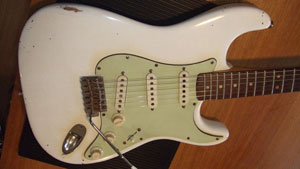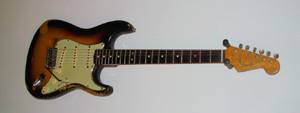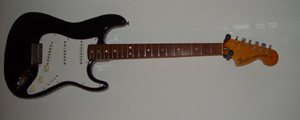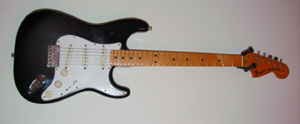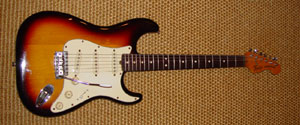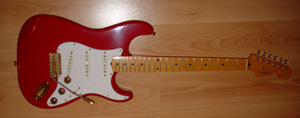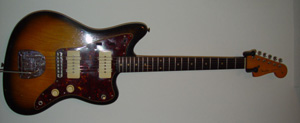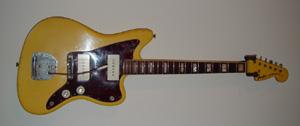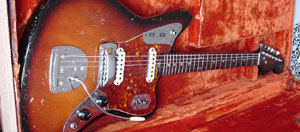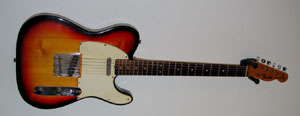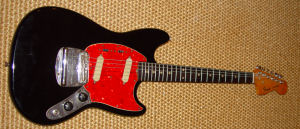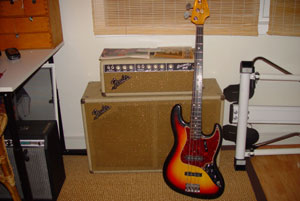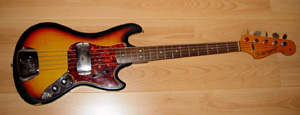|
The Collection |
|||
|
The
Custom was also sometimes called the 'fretless wonder', due to
the fact that the fret wire used was flatter and wider than on the
Gold Top, which, combined with an ebony fretboard, made it
seem easier to play. The Custom was fitted with a standard P90 pickup in the bridge position but a newly designed single coil pickup in the neck position. The new pickup was visibly different from a P90 in that the polepieces were rectangular; it was also louder than a P90. Known as the Alnico pickup due to its use of aluminum/nickel/cobalt alloy, the unit was designed by Seth Lover. More........ Price G Base |
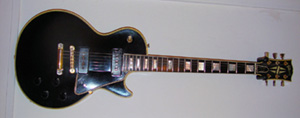 Gibson Les Paul Black Beauty 1955 |
||
| The Fender Electric Instrument Manufacturing Company (now known as Fender Musical Instruments Corporation) developed the first commercial solid-body 'Spanish' (as opposed to 'Hawaiian,' or lap steel) electric guitar in the Telecaster, a simple design whose earliest models were offered under various names beginning in 1950. Though the Telecaster and its variants were successful, many guitar players of the day insisted on using a Bigsby unit, a fairly primitive spring-loaded vibrato device with which players could bend notes up and down with their pick hand. Instead of adding a Bigsby, Fender decided to produce a new, more expensively-made line of guitar with his own design of vibrato. More.... Price G Base |
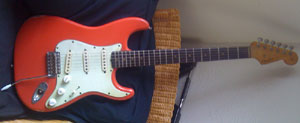 Fender Stratocaster Feiesta Red1963 |
||
| The Stratocaster appeared in Selmer's UK March 1963 catalogue, priced at 160 guineas (£168) in red or 153 guineas (£160/13 shillings) in sunburst. A case was extra. At these prices most aspiring UK guitarists could only drool at the catalogue or the shop window. Anyone fortunate enough to have bought one then and kept it in A1 condition would have made a very sound investment, with early mint condition instruments now fetching prices in the tens of thousands. Even more desirable to collectors are Strats with the provenance of having been played by their guitar heros More... Price G Base |
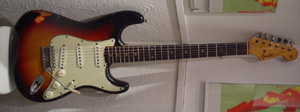 Fender Stratocaster June 1963 |
||
| The Fender Stratocaster is no less than one of the most popular, recognizable, influential, and best-selling electric guitars ever made. The Stratocaster was introduced in 1954 and has thrived fundamentally unchanged throughout 47 years of production, becoming the favored instrument of millions of guitarists including Eric Clapton, Jimi Hendrix, Mark Knopfler, David Gilmour, and Stevie Ray Vaughan. The Stratocaster—along with another revolutionary guitar, the Gibson Les Paul—stands head and shoulders above any other solid body electric guitar made. Ever. It is a model of good product design. More.... Price GBase | |||
|
The name, 'Stratocaster,'
was intended to evoke images of newly emergent
jet-aircraft technology (such as the Boeing B-52
Stratofortress), and to express Fender's modernistic
design philosophy. In designing the Stratocaster's body,
a significant area of the back of the guitar, and the
area where the strumming arm rests, were beveled to
accommodate the player's chest and arm. The upper bouts
featured two cutaways, for easier access to the higher
frets. The new 'Custom Contour Body' and 'Synchronized
Tremolo' bridge made the Stratocaster a revolutionary
design. The guitar also featured more complex
electronics than the Telecaster: a then unheard-of three
single coil pickups, each with staggered magnetic poles;
a three-way selector switch; one volume knob, and two
tone controls.
Price G Base
|
|||
| Introduction of the three-bolt neck plate with Micro-Tilt adjustment system. Truss rod adjustment switched to the "bullet" style at the headstock instead of at the body end of the neck. Bridge saddles are no longer stamped and bridge becomes a one-piece die cast chrome, replacing the two-piece bridge. Most of these changes occur in late 1971.The Stratocaster fell out of fashion in the mid-sixties, to the point where the Fender company (Leo Fender had sold it to CBS for $13 million in January 1965) reduced its price and considered removing it from their production line. However, Jimi Hendrix and many other blues-influenced artists of the late '60s soon adopted the Stratocaster as their main instrument, reviving the guitar's popularity. More.... Price G Base | |||
| In 1959-1967, the Stratocaster was refitted with a rosewood fretboard, as well as color choices other than sunburst, including a variety of colorful car-like paint jobs that appealed to the nascent surfer and hot-rod culture, pioneered by such bands as the Ventures and the Beach Boys. The maple fingerboard discontinued in 1959 was reintroduced as an option in 1967, the guitar could be purchased with either a maple or a rosewood fretboard. Other, often subtle changes were made to the guitars over the years, as though in the spirit of tinkering for which Leo Fender was famous, but the basic shape and features of the Strat remained unchanged. More... Price G Base | |||
| As Fender Stratocaster fans around the world anxiously await the unveiling of 2004's 50th Anniversary Stratocaster, what better time to take a look back at the instrument that marked the 25th Silver Anniversary of the Fender Stratocaster. In 1979, Fender celebrated the 25th anniversary of the Stratocaster (introduced in 1954) with the first "anniversary" instrument, and the first Fender instrument to be issued in a pre-determined and numbered, limited quantity .The first 500 or so instruments produced were finished in Pearl White. However, due to the instability of the finish and the checking that resulted, many were recalled and re-finished in Porsche Silver (though Fender refers to it as "25th Anniversary Stratocaster Silver"), the color that was used in the rest of the production run. An example of the checking problem with the Pearl White finish More... Price G Base |
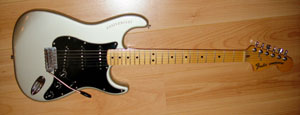 Fender Stratocaster Anniversary 1978 |
||
| Specs: An important transition year. While at the beginning of 1981 the basic model is still the 1976 version, by the end of the year a new model will go into production: the Standard Stratocaster, also known as the Dan Smith Strat, that is clearly a return to pre-CBS design principles: smaller headstock, four bolt neck, and body end truss rod adjustement (no bullet) - it does, however, retain the CBS-style logo decal (see 1982). Note: some transition variations can be found, such as white plastic, four-bolt neck, bullet truss rod adjustment and large headstock. Price G Base |
|
||
| The "STRAT", a customized and souped-up variation of the Stratocaster, was introduced by Fender at the 1980 NAMM Show. Designed by Gregg Wilson, then chief of guitar R&D at Fender, with the help of Dan Armstrong serving as a consultant, the STRAT tried to blend classic features with modern electronics to rejuvenate the Stratocaster concept. With the STRAT model, Fender gave a nod to the past by reinstating the smaller 1954-1965 pre-CBS headstock design (however, since the original worn-out tooling was used, the STRAT headstock, though smaller than the CBS era design, was not an entirely accurate re-creation of the pre-CBS model); and, like the 1979 25th Stratocaster Anniversary models, the STRAT was fitted with the popular pre-CBS style truss-rod adjustment and four-bolt neck plate, replacing the CBS Bullet truss rod adjustment and three-bolt neck plate. Price G Base |
|
||
|
After a peak in the 1970s, driven by
players such as David Gilmour of Pink Floyd, another lull occurred
in the early '80s, during which the Fender company cut costs by
deleting features from the standard Stratocaster line, despite a
blues revival that featured Strat players such as Stevie Ray Vaughan,
Robert Cray, and Buddy Guy. However, once the company became
independent of CBS, the trend abated with a rise in mainstream
popularity for vintage (and vintage-style) instruments. More.... Price G Base |
|||
| Fender Stratocaster 1979 International Colour. An important transition year. While at the beginning of 1981 the basic model is still the 1976 version, by the end of the year a new model will go into production: the Standard Stratocaster, also known as the Dan Smith Strat, that is clearly a return to pre-CBS design principles: smaller headstock, four bolt neck, and body end truss rod adustement (no bullet) - it does, however, retain the CBS-style logo decal (see 1982). Note: some transition variations can be found, such as white plastic, four-bolt neck, bullet truss rod adustment and large headstock, as seen in the second image below). Also offered this year: the International Color series Strats, of which one, Monaco Blue, is pictured below. Apart from their colors, they're basically a '76 Stratocaster with the exception of the Sahara Taupe model that has a four bolt, no bullet design |
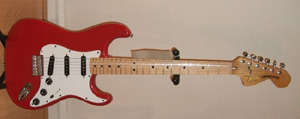 Fender Stratocaster 1979 |
||
|
In the midst of its scramble to compete
with Fender by developing its radical Flying V and Explorer guitars,
the Gibson company likely didn’t realize that Leo Fender was
similarly trying to loosen its grip on the jazz guitar market of the
late 1950s.At the time, Gibson’s grasp on the segment was indeed
firm. Its hollow and semi-hollowbody electrics, along with the
introduction of the warm, midrangey humbucking pickup combined to
give most jazz players exactly what they were looking for in terms
of feel, tone, and playability. Plus, among the sometimes
hoity-toity jazzer set, More... Price G Base |
|||
|
When Fender
introduced the Jazzmaster in 1958, it was
designed to replace the Stratocaster as the
top model. It featured a new body shape –
the “Offset Waist Contour Body”, that meant
to provide a better balance and comfort. The
Jazzmaster was an attempt to enter the jazz
market, too, so it was equipped with newly
designed pickups with a mellower sound than
the Stratocaster or the Telecaster, rather
like a hollow body guitar. Unlike the single
coils of the Stratocaster, the single coils
of the Jazzmaster are wide and rather flat,
covered in a white rectangular housing. So
they pick up a wider area of the vibrating
strings and thus their sound is less
“pointy”.
|
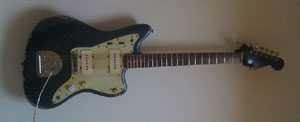 Fender Jazzmaster Sherwood Green 1963 |
||
| So it was that in 1957, Leo began tinkering on a design that would go beyond anything he’d previously attempted. He started by changing the body, giving it different curves and a bit more size. Bouts featured softer corners, and the instrument’s “waist” was offset slightly, so if a player preferred to sit down, it would balance comfortably. Leo believed high-brow or “old-school” players sat dow played, and he wanted the body to be comfortable in the most popular positions for sitting (it must have been an important element, given that the patent application contained drawings of a man sitting in two positions, Jazzmaster snugly in place). He also incorporated the Strat’s beveled back and arm contours, which were key to that model’s popularity. More.... Price G Base | |||
| The neck of the
Jaguar is a short 24" scale containing 22 frets. A new "Fender
First" in the Jaguar is the Fender Mute. This movable string mute is
attached to the bridge and may be activated or disengaged by a light
touch of the finger. With the Fender Mute it is no longer necessary
to remove the bridge cover and dampen the strings with the hand to
shorten the sustaining period of the notes. Other features of the
Jaguar are: newly designed wide-range pickups, on-off pickup
switches with controls making possible six different tone selections
plus standard tone and volume controls, rhythem circuit, Fender
"Floating Tremolo", "Off-set" waist design, and adjustable neck
truss rod. ." Price G Base |
|||
| The Telecaster was
developed by Leo Fender in Fullerton, California, in the 1940s. But
like many great ideas, the solid-body electric guitar was created
independently by several craftsman and companies over a similar
period (roughly 1932-1949), such that any claim of a 'first' demands
a great deal of qualification. Leo Fender's Telecaster was simply
the right guitar at the right time, and like many other great ideas,
it began as an accident. Price G Base |
|||
| In late 1968, Fender introduced the Telecaster Thinline. Much like Gibson's 335, the Thinline has a solid center with hollow "wings" and a single "F" hole.When it was introduced in late 1968, the Telecaster Thinline was offered with either a natural finished ash or mahogany body. In 1969, a three tone sunburst finish was also offered as an option. Also in 1969 the maple cap fingerboard gave way to a one piece maple neck with the back "skunk stripe". Finally in late-1971, the Telecaster Thinline was outfitted with a pair of Fender’s new humbucking pickups and it remained unchanged in the Fender line until it was discontinued in 1980. More.... Price G Base |
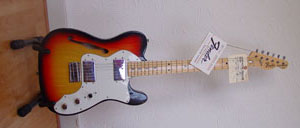 Fender telecaster Thinline 1976 |
||
|
The Telecaster Custom was an
attempt to enter the humbucker market largely
dominated by Gibson. Fender's first humbucking
design was the wide range humbucker created by Seth
Lover, who had overseen the development of the
original Gibson humbucker. Lover's Fender humbucker
is felt by many to be brighter with more bottom end
than his Gibson versions, and a better match for the
classic Fender bridge pickup.The original Telecaster
Custom was in production from 1972 until 1981. Early
examples sported a curly "Custom" logo and "Welsh-hat"
vol and tone knobs. Later examples differed; the
knobs changed to Stratocaster types, and the "Custom"
logo changed to the standard italicized block
typeface used for Fenders of the period.
|
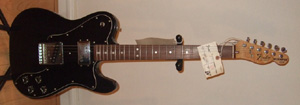 Fender telecaster Custom 1978 |
||
|
Fender introduced Mustang during August 1964. The Mustang model brought new improvements over its Musicmaster and Duosonic counterpart. The Mustang was designed by Leo Fender while he still owned the company. It was based on the Fender Duo-Sonic with the addition of a new bridge assembly, Dynamic Fender Vibrato tailpiece and tremolo arm.Tim Pershing: "The redesign and introduction of the Musicmaster and Duosonic coincided with the introduction of the Mustang (August 1964). I would say that, clearly, the Mustang inspired the redesign of the other student guitars, or the change in design. The earliest production Mustang neck date I've seen is JUL 64. |
|
||
|
The Fender Musicmaster is an
electric guitar by Fender, and was the first of
their 3/4
scale guitars. Design work on the Musicmaster
and a two-pickup version the Duo-Sonic began in late
1955 following a request from the Sales Department.
Prototypes were made in early 1956, followed by
sales literature announcing both models. Production
of the Musicmaster began in late April of that year,
using a body routed for two pickups to be common to
the Duo-Sonic, which followed a little more than two
months later. The Duo-Sonic and Musicmaster also
shared a single piece maple neck and fingerboard,
with a 22.5 inch scale length and 21 frets.There was
one major redesign of these two Musicmaster-bodied
guitars, in 1959 when the entire Fender catalog was
updated. At this time the Musicmaster and Duo-Sonic
both received a plastic pickguard in place of the
previous anodized aluminum, and a two-piece maple
neck with a rosewood fingerboard.
|
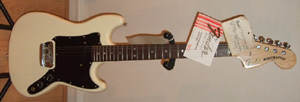 Fender Musicmaster 1978 |
||
| The Starcaster was a high quality instrument (designed by Gene Fields) manufactured at a time when Fender's standards had lowered considerably. It was commercially unsuccessful, perhaps because of a public notion that Fender was a "solidbody, single coil brand" and Gibson was the "semi-hollow, humbucker brand". Although the Starcaster was semi-hollow and had humbucker pickups, it retained Fender's bolt-on neck design (using a somewhat trouble-prone three-bolt joint that it shared with other Fenders of the time), which may have added to its unpopularity. As a result it was only in production from 1976 or 1977 to 1980 or 1982, depending on sources. It had a unique headstock design, with a painted bottom curve matching the color of the guitar body, that no other Fender guitar has had before or since. |
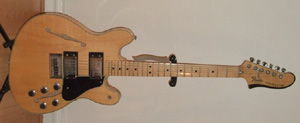 Fender Starcaster 1977 |
||
|
The Fender Coronado is a
double-cutaway six-string hollow-body electric
guitar. The very un-Fender like
instruments were designed by Roger Rossmeisl, who
had also designed for Rickenbacker previously, and
went on to create numerous models for Fender.Three
versions of the Coronado were produced from 1966.
The Fender Coronado I was the original single pickup
design and the Coronado II, had an added bridge
pickup. The Coronado XII was the two pickup model,
with twelve stringsThe Coronado II and Coronado XII
were also offered in Wildwood finish; a veneer of
heavily grained beech, made by injecting chemicals
into growing trees, years before harvesting.
|
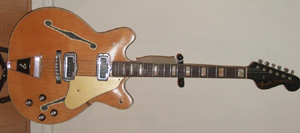 Fender Coronado II1966 |
||
|
This
was done to make it easier for upright-bass players to make the
switch to electric bass. It has three control knobs (instead of the
two of the Fender Precision Bass), two of them controlling the
volume of the two pickups and one for the overall tone.A fourth,
push button control is available on some models of Jazz Bass
produced after mid-2003. Known as the "S-1 Switch" this feature
allows the pickups to operate in standard, parallel wiring, or
alternatively in series wiring when the switch is depressed. Blonde Bassman Fifty: These amps were produced at the same time as the brown amps, but were covered in a white (more like biege) Tolex and had round white knobs. This color scheme was reserved for the new "piggyback" amps (Showman, Bassman, Tremolux, Bandmaster) and the Twin combo. Early blonde Tolex had a rough texture while later amps have a smoother surface. Grille cloth varied with early amps having the brown grille cloth of the tweed amps. Later amps had maroon grille cloth, and the last having a wheat or gold sparkle color. The handle was changed to a brown plastic strap which held up a little bit better than the leather handles Fender had been using for over a decade. More ... |
|||
| The originial Fender Bass V was a quirky and unusual electric bass guitar model produced by Fender between 1965 and 1970. It was the world's first five string bass guitar, a popular concept today that, like many of Leo Fender's ideas, was well ahead of its time.The Fender Bass V is unusual in its dimensions: Although it is three inches longer than a P-Bass, the Fender Bass V inexplicably has only 15 frets. A high C string was added to a combination of traditional Fender body designs. (At the time, not much about electric bass construction was traditional because it was still a brand new technology.) Only about 200 Fender Bass V models were produced, before being discontinued in 1970. | |||
|
Ibanez This 1978 Ibanez Custom 2350,
made in Japan, features a mahogany body, arched birch top with an
ebony finish. It has a laminate maple neck with 22 frets, inlays and
a bound Rosewood fingerboard. It also features the original ornate
Ibanez bridge and star tuners. This guitar was made in
September of 1978, roughlyone year after the infamous Gibson vs.
Ibanez lawsuit began. |
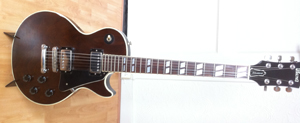 |
||
| Ibanez 2342 1976 |
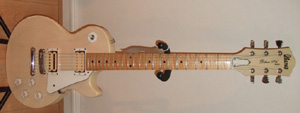 |
||
|
Manhattan Guitar, 1961 Was made at the
Egmond factory which was the main supplier for electric guitars in
the Netherlands. This Manhattan model does not have a lot of vintage
value but for me its an emotional thing because my father designed
it. He was owner of a music shop called Manhattan, and this guitar
was produced in the beginning of the 60's. It was made from plywood and used one pickup. I hope to find more of these guitars. |
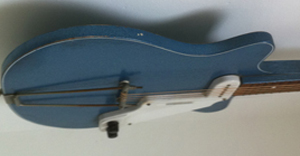 |
||
|
Ibanez SC500AV Nylon Electric Acoustic
guitar. Made in 1997 in Japan. This is what they now call a Prestige
Model.Finish: Natural, Antique Violin Fretboard: Rosewood Neck: Mahogany Body: Mahogany Back & Sides: Not Available Pickups: Piezo Transducer.See and hear the SC500 http://www.youtube.com/watch?v=A4TkgLnkBs4 |
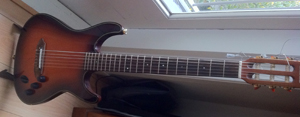 |
||
| Bozo Podunavac (pronounced bo-zho pod oo nav ack) is a Serbian born master luthier / guitar builder who emigrated to the U.S. in 1959. He was raised in Belgrade, Yugoslavia and served his apprenticeship with master luthier Milutin Mladenovic and graduated in 1950. He moved to Chicago, when he came to the US and for a time worked in the repair department of a musical instruments dealer and manufacturer. In 1964 he opened his own shop and began building guitars with his name "Bozo" on the peghead. Bozo apprenticed in the old world tradition of his homeland, and relishes building highly ornate instruments. |
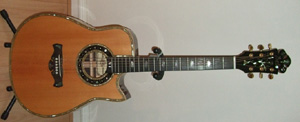 Bozo 399-78 |
||
|
Ibanez Artwood AW150 This beautiful guitar was owned by my father. This is the last acoustic Ibanez guitar produced in Japan.Unfortunately Ibanez was forced to move the production to Korea because the production costs increased enormously.. It had a nice solid sprucetop, and Jacaranda Back & side with Mahogany Neck. The sound is warm and bright. |
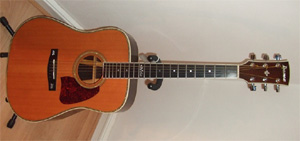 Ibanez AW150 |
||
|
Ovation Legend
1617 Body Type: Deep Bowl Top: Sitka Spruce AAA Bracing: Ovation A Scale Length: 25 1/4" Scale: Fretboard: Ebony, Ivory Binding Fret Inlay: 15 Pearl Bridge: Walnut Rosette: Pickup: Piezoelectric Nutwidth: 1 11/16" Machines: Deluxe 24k Gold Plated Case: |
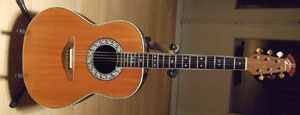 Ovation Legend 1617 |
||
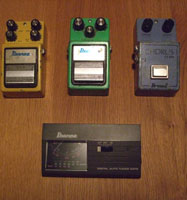 |
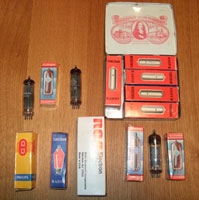 |
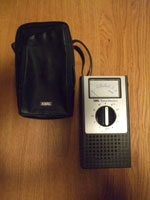 |
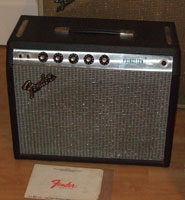 |
